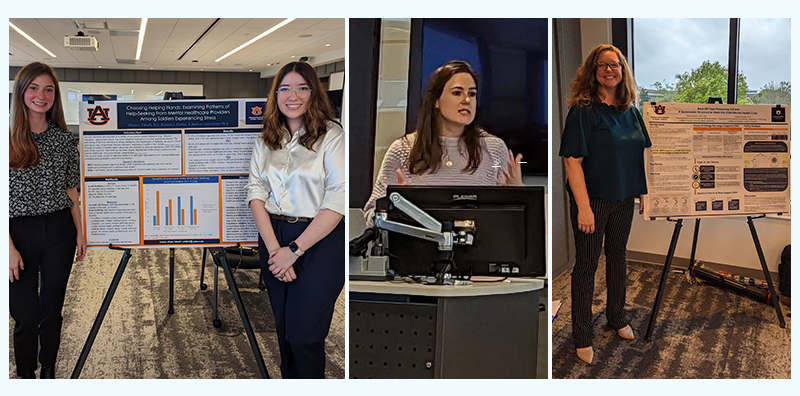Unit cohesion is the extent to which military service members feel committed to and supported by their military unit or, conversely, feel overlooked, neglected, and/or alienated. Unit cohesion reflects an important aspect of military social support and can act as a protective factor against mental health challenges, particularly in challenging situations. Theoretical suppositions and emerging evidence suggest that different types of unit support, specifically, vertical unit cohesion and horizontal unit cohesion, uniquely matter for service member well-being. Vertical unit cohesion (support from leaders in the unit and other higher-ranking positions) may be of universal importance to service members with implications for career progression and personal wellbeing, while horizontal unit cohesion (support from fellow unit members and peers) may be of importance under certain circumstances. Informed by the psychometric theory of scale development and validation, the dimensionality of unit cohesion theory, and the need for brief, sound measurement tools, this study first examined the psychometric properties of the Army STARRS four-item Vertical Unit Cohesion Scale in a longitudinal analysis with a large, diverse sample of Soldiers from the Pre/Post Deployment Study component of the Army STARRS dataset (N = 10,116). Then, exploratory analyses were conducted to examine the properties of the Horizontal Unit Cohesion Scale and understand the relationship between vertical and horizontal unit cohesion. Strong evidence for the Vertical Unit Cohesion Scale’s psychometric soundness was established regarding factor structure, measurement invariance overtime, and construct validity. Conversely, preliminary evidence suggests that the three-item measure of Horizontal Unit Cohesion should be used with caution. Implications for researchers and military leadership are provided.
Library (10)
Research in Action (10)
Featured News (5)
Showing library results for: Haley Sherman
APA Citation:
Cooper, E., Vandenberg, C., Sjolseth, S., Short, K., Sherman, H., Hanson, E., O’Neal, C. W., & Lucier- Greer, M. (2024). Promoting adolescent well-being: Drawing from basic and applied developmental frameworks and research. Auburn, AL: Military REACH.
Focus:
Children
Youth
Programming
Mental health
Physical health
Branch of Service:
Multiple branches
Military Affiliation:
Active Duty
Population:
Childhood (birth - 12 yrs)
School age (6 - 12 yrs)
Adolescence (13 - 17 yrs)
APA Citation:
Sherman, H., & Lucier-Greer, M. (2024). Assessing the psychometric properties of the Army STARRS’ vertical unit cohesion scale: A large-scale, longitudinal study. Military Psychology. Advance online publication. https://doi.org/10.1080/08995605.2024.2370705
Focus:
Mental health
Programming
Branch of Service:
Army
Military Affiliation:
Active Duty
Population:
Adulthood (18 yrs & older)
Young adulthood (18 - 29 yrs)
Thirties (30 - 39 yrs)
Middle age (40 - 64 yrs)
APA Citation:
Cooper, E., Vandenberg, C., Hanson, E., Sherman, H., Saxey, M., Tidwell, A., O’Neal, C. W., & Lucier-Greer, M. (2024). Empowering through education: Frameworks for relationship education, parent education, and sexual violence prevention. Auburn, AL: Military REACH.
Focus:
Children
Youth
Parents
Couples
Programming
Trauma
Mental health
Branch of Service:
Multiple branches
Military Affiliation:
Active Duty
Guard
Reserve
Population:
Childhood (birth - 12 yrs)
Adolescence (13 - 17 yrs)
Adulthood (18 yrs & older)
Young adulthood (18 - 29 yrs)
Thirties (30 - 39 yrs)
Middle age (40 - 64 yrs)
APA Citation:
Sherman, H. (2024). Investigations into religious coping among United States veterans: A lens on measurement and implications for psychological wellbeing [PhD, Auburn University ]. https://etd.auburn.edu//handle/10415/9141
Focus:
Veterans
Mental health
Programming
Other
Branch of Service:
Multiple branches
Military Affiliation:
Veteran
Population:
Adulthood (18 yrs & older)
Young adulthood (18 - 29 yrs)
Thirties (30 - 39 yrs)
Middle age (40 - 64 yrs)
Authors: Sherman, Haley; Lucier-Greer, Mallory
Year: 2024
Abstract
Pew Research Institute estimates that in 2020 approximately 70% of individuals in the United States (U.S.) identified as religious with some ties to a religious community or belief system (e.g., Christian, Jewish, Muslim, Hindu, Buddhist; Nadeem, 2022), and similar to the larger population, Service members in the U.S. military also identify as religious in high percentages (i.e., 70% identifying as Christian including non-denominational, Catholic, Protestant, and Mormon; National Academies of Sciences et al., 2019). Religion is multipurpose in that it may provide comfort, stimulate growth, enhance intimacy with a Higher Power, facilitate closeness with others, and/or offer meaning and purpose to life. As such, the use of religion as a resource in the context of stress, a term called religious coping, has been studied systematically in a variety of populations. Within the religious coping literature, two types of religious coping have been identified, positive and negative. Previous research shows that these forms of coping are different, but related constructs that are uniquely related to different health and wellbeing outcomes for those who value religion. In this dissertation, the constructs of positive religious coping and negative religious coping were examined through a psychometric lens and as distinct mechanisms with implications for the wellbeing of Veterans (N=170). Study 1 was a psychometric analysis of the two-factor Brief Religious Coping Scale (Brief RCOPE; Pargament et al., 2011; i.e., comprised of positive and negative religious coping subscales), that examined the suitability of the measure in a Veteran sample, and Study 2 utilized a theoretically grounded stress process lens to examine the implications of religious coping for Veterans’ self-concepts and, in turn, wellbeing. Grounded in best practices for measurement evaluation and informed by the psychometric theory of scale development and validation, the first study used a confirmatory factor analysis, t-test, and validity testing to examine the psychometric properties of the two-factor Brief RCOPE Scale (Pargament et al., 2011) in a sample of Veterans which, to our knowledge, had not been done previously. The results indicated that two distinct subscales did emerge, but in a slightly adapted manner. For the Negative Religious Coping Scale, specifically, only six items, as opposed to the original seven items, were identified as appropriate to assess the construct; the indicator attributing the devil or evil to a given stressful context (i.e., “decided the devil/evil made this happen”) was removed. The results from the Positive Religious Coping Scale indicated that all seven of the original items were appropriate for assessing the construct of positive religious coping. Implications for researchers, clinicians, and military chaplains were provided. The second study, informed by Pearlin and colleague’s (1981) Stress Process Model, employed an indirect effects path model to understand the associations between religious coping (positive and negative), self-concepts (self-forgiveness and self-efficacy), and wellbeing. First the association between positive religious coping, negative religious coping, and psychological wellbeing were examined. Then, the roles of self-forgiveness and self-efficacy were included in the model to determine if they explained the associations between religious coping and psychological wellbeing. The results indicated that negative religious coping, but not positive, was negatively associated with both self-concepts, and, in turn, these self-concepts were positively associated with psychological wellbeing. Positive religious coping was not associated with either self-concept or the outcome of psychological wellbeing, nor was it correlated with negative religious coping. Previous research suggests that positive religious coping is nuanced and not uniformly a protective factor, as was the case in this study. Therefore, while our hypotheses for positive religious coping were not supported, the overall findings can be understood within the context of previous literature. Implications for researchers, clinicians, policy makers, and religious leaders were provided. Overall, the two studies conveyed the importance of assessing the psychometric properties of scales before implementing them into theoretically constructed models and furthered both the psychometric assessment literature for the two-factor Brief RCOPE Scale and the literature on the use of positive and negative religious coping, self-forgiveness, self-efficacy, and psychological wellbeing with Veteran samples.
5 A review of evidence-based strategies to help military families navigate relocation
APA Citation:
Vandenberg, C., Hanson, E., Tidwell, A., Sherman, H., Chen, C.-F., O’Neal, C. W., & Lucier-Greer, M. (2023). A review of evidence-based strategies to help military families navigate relocation. Auburn, AL: Military REACH.
Focus:
Children
Youth
Parents
Couples
Mental health
Physical health
Branch of Service:
Army
Navy
Air Force
Coast Guard
Marine Corps
Multiple branches
Military Affiliation:
Active Duty
Population:
Childhood (birth - 12 yrs)
Preschool age (2 -5 yrs)
School age (6 - 12 yrs)
Adolescence (13 - 17 yrs)
Adulthood (18 yrs & older)
Young adulthood (18 - 29 yrs)
Thirties (30 - 39 yrs)
Middle age (40 - 64 yrs)
APA Citation:
Sherman, H., O’Neal, C. W., Tidwell, A., & Lucier-Greer, M. (2023). Adolescent difficulties during parental deployment and anxiety: A focus on measurement and family processes. Child & Family Social Work, 28(4), 1110-1120. https://doi.org/10.1111/cfs.13030
Focus:
Youth
Deployment
Parents
Mental health
Branch of Service:
Army
Military Affiliation:
Active Duty
Population:
Young adulthood (18 - 29 yrs)
Adulthood (18 yrs & older)
Thirties (30 - 39 yrs)
Middle age (40 - 64 yrs)
Authors: Sherman, Haley; O'Neal, Catherine Walker; Tidwell, Allison; Lucier-Greer, Mallory
Year: 2023
Abstract
Approximately 60% of deployed service members leave behind immediate family members, and although military families tend to be adaptive and resilient, evidence suggests that deployments are challenging and difficulties can arise during transitions and family separation, especially for adolescents. Grounded in the family attachment network model and the ABC-X model of family stress, the current study utilized a sample of 204 military families with an active-duty father, civilian mother and adolescent and examined parents' perceptions of adolescents' difficulties during deployment in relation to all three family members' perceptions of the adolescents' mental health (i.e., anxiety symptoms) following deployment. First, analyses of measurement invariance indicated that service members and civilian parents were generally reporting on the same underlying construct of their adolescents' difficulties during parental deployment. Next, a structural equation model demonstrated considerable overlap in service member and civilian parent reports of their adolescents' difficulties during a parental deployment (r = 0.47). Finally, both parents' perceptions of adolescent difficulties during parental deployment were related to their own perceptions of the adolescent's current anxiety but not to the adolescents' reports of their own anxiety symptoms or to the other parent's report of the adolescents' anxiety symptoms. Findings provide support for utilizing these theories in combination, such that disruptions to the family system, and the attachment relationships within that system, in one stage of the deployment cycle, may imply that there are implications for individual-level functioning, namely, anxiety, in the next stage of the deployment cycle. Findings also underscore the importance of examining our measurement tools and collecting data from multiple family members to understand family processes.
APA Citation:
Frye-Cox, N., Sherman, H., Tidwell, A., O’Neal, C. W., & Lucier-Greer, M. (2021). Helping school personnel prevent and de-escalate peer aggression: An overview of existing research and insights into programming. Auburn, AL: Military REACH
Focus:
Children
Youth
Parents
Programming
Population:
Childhood (birth - 12 yrs)
School age (6 - 12 yrs)
Adolescence (13 - 17 yrs)
APA Citation:
Sherman, H., Frye-Cox, N., & Lucier-Greer, M. (2021). Combat deployment experiences and solider mental health: Examining the factor structure of a combat experiences scale. Military Medicine, usab456. https://doi.org/10.1093/milmed/usab456
Focus:
Mental health
Branch of Service:
Army
Population:
Adulthood (18 yrs & older)
Young adulthood (18 - 29 yrs)
Thirties (30 - 39 yrs)
Middle age (40 - 64 yrs)
Authors: Sherman, Haley; Frye-Cox, Nicky; Lucier-Greer, Mallory
Year: 2021
Abstract
Researchers and practitioners are invested in understanding how deployment experiences impact the nearly 193,000 U.S. service members who deploy in a given year. Yet, there remains a need to adequately identify salient deployment experiences through survey measurement tools and understand how differential experiences are uniquely related to mental health outcomes. Therefore, this study examined the factor structure of an established combat experiences measure from the Army Study to Assess Risk and Resilience in Service members (Army STARRS) dataset to identify underlying survey constructs that reflect nuanced deployment experiences. Then, we examined the association between diverse combat experiences and current mental health symptoms (i.e., anxiety and depressive symptoms) and the mediating role of coping.Data were drawn from the Army STARRS data (N = 14,860 soldiers), specifically the All Army Study component. A principal component analysis (PCA) was conducted to examine the dimensionality of the combat experiences scale, and then a path model was conducted to examine the relationships between combat experiences, coping with stress following a deployment, and mental health symptoms while controlling for relevant individual and interpersonal factors.Results from the principal component analysis suggested that the Army STARRS combat experiences scale encompasses two components, specifically: “Expected combat experiences” and “Responsible for non-enemy deaths.” Both “Expected combat experiences” and “Responsible for non-enemy deaths” were associated with higher levels of anxiety and depressive symptoms, respectively, and “Responsible for non-enemy deaths” was also indirectly linked to these mental health outcomes through coping with stress after deployment.These findings provide insight into the dimensionality of combat experiences and offer practitioners a more nuanced understanding of how to process unique combat experiences that differentially relate to mental health symptoms.
APA Citation:
Lucier-Greer, M., Quichocho, D., Frye-Cox, N., Sherman, H., Burke, B., & Duncan, J. M. (2020). Coping and mental health differences among active duty service members and their spouses with high and low levels of marital warmth. Military Psychology, 32, 425-431. https://doi.org/10.1080/08995605.2020.1803724
Focus:
Couples
Mental health
Parents
Branch of Service:
Multiple branches
Military Affiliation:
Active Duty
Population:
Thirties (30 - 39 yrs)
Middle age (40 - 64 yrs)
Authors: Lucier-Greer, Mallory; Quichocho, Davina; Frye-Cox, Nicky; Sherman, Haley; Burke, Benjamin; Duncan, James M.
Year: 2020
Abstract
This study examined the relationship between marital warmth (e.g., openly expressing affection, supportive behaviors) and assessments of coping (i.e., challenges coping with military life and self-efficacy in the context of stress) and mental health (i.e., depressive symptoms and anxiety symptoms) in a sample of active duty men and their spouses/romantic partners (N = 234 military couples). Results from a series of multivariate analysis of variance tests indicate that service members and spouses who reported higher levels of marital warmth also reported better coping skills and mental health compared to individuals in couple relationships that demonstrated lower levels of marital warmth. Intervention and prevention implications targeting social support and marital warmth are provided.
APA Citation:
Burke, B., Lucier-Greer, M., Quichocho, D., Sherman, H., Nichols, L., & O’Neal, C. W. (2019). A review and application of posttraumatic growth for enhancing the well-being of military service members and their families. Auburn, AL: Military REACH.
Focus:
Children
Youth
Parents
Couples
Deployment
Trauma
Mental health
Physical health
Veterans
Branch of Service:
Army
Navy
Air Force
Marine Corps
Multiple branches
Population:
Childhood (birth - 12 yrs)
Infancy (2 - 23 mo)
Preschool age (2 -5 yrs)
School age (6 - 12 yrs)
Adolescence (13 - 17 yrs)
Adulthood (18 yrs & older)
Young adulthood (18 - 29 yrs)
Thirties (30 - 39 yrs)
Middle age (40 - 64 yrs)
Aged (65 yrs & older)
Very old (85 yrs & older)
HALEY SHERMAN: CINDY WINTER SCHOLARSHIP AWARD RECIPIENT
COLLEGE OF HUMAN SCIENCES RESEARCH SYMPOSIUM
HALEY SHERMAN RECEIVES TWO PRESTEGIOUS AWARDS
STUDENT HIGHLIGHTS: HALEY SHERMAN, RESEARCH TEAM
HALEY SHERMAN: EXCELLENCE IN RESEARCH AND MENTORSHIP
Showing monthly topics for: Haley Sherman
CULTIVATING COMMUNITY CONNECTIONS
Parent-Child Communication during Deployment

Loading








